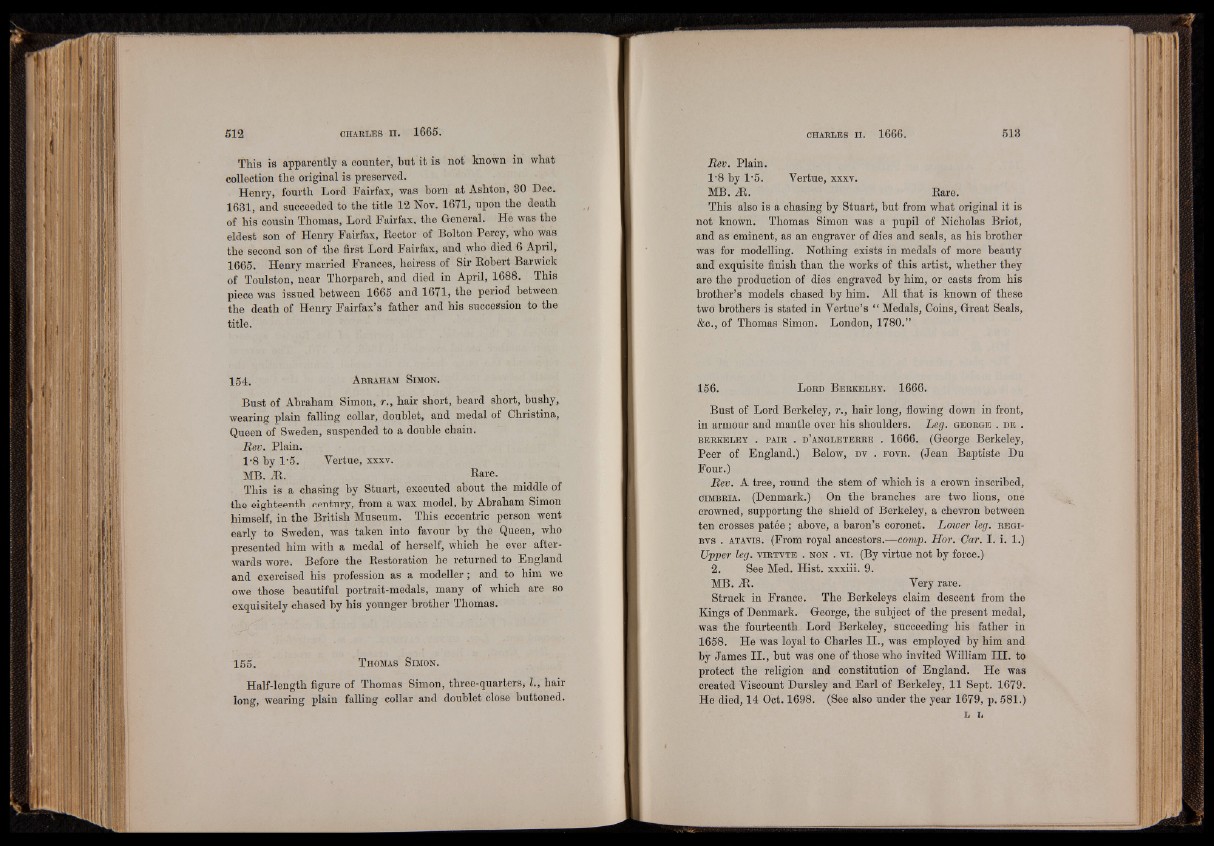
This is apparently a counter, but it is not known in what
collection the original is preserved.
Henry, fourth Lord Fairfax, was born at Ashton, 30 Dec.
1631, and succeeded to the title 12 Nov. 1671, upon the death
of his cousin Thomas, Lord Fairfax, the General. He was the
eldest son of Henry Fairfax, Rector of Bolton Percy, who was
the second son of the first Lord Fairfax, and who died 6 April,
1665. Henry married Frances, heiress of Sir Robert Barwick
of Toulston, near Thorparch, and died in April, 1688. This
piece was issued between 1665 and 1671, the period between
the death of Henry Fairfax’s father and his succession to the
title.
154. Abraham Simon.
Bust of Abraham Simon, r., hair short, beard short, bushy,
wearing plain falling collar, doublet, and medal of Christina,
Queen of Sweden, suspended to a double chain.
Rev. Plain.
1-8 by 1*5. Yertue, xxxv.
MB. At. Rare.
This is a chasing by Stuart, executed about the middle of
the eighteenth century, from a wax model, by Abraham Simon
himself, in the British Museum. This eccentric person went
early to Sweden, was taken into favour by the Queen, who
presented him with a medal of herself, which he ever afterwards
wore. Before the Restoration he returned to England
and exercised his profession as a modeller; and to him we
owe those beautiful portrait-medals, many of which are so
exquisitely chased by his younger brother Thomas.
1 5 5 . T homas Simon.
Half-length figure of Thomas Simon, three-quarters, I , hair
long, wearing plain falling collar and doublet close buttoned.
Rev. Plain.
1'8 by 1*5. Yertue, xxxv.
MB. At. Rare.
This also is a chasing by Stuart, but from what original it is
not known. Thomas Simon was a pupil of Nicholas Briot,
and as eminent, as an engraver of dies and seals, as his brother
was for modelling. Nothing exists in medals of more beauty
and exquisite finish than the works of this artist, whether they
are the production of dies engraved by him, or casts from his
brother’s models chased by him. All that is known of these
two brothers is stated in Yertue’s “ Medals, Goins, Great Seals,
&c., of Thomas Simon. London, 1780.”
156. L ord B erkeley; 1666.
Bust of Lord Berkeley, r., hair long, flowing down in front,
in armour and mantle over his shoulders. Leg. g eo r g e . d e .
b e r k e l e y . p a ir . d ’a n g l e t e r r e . 1666. (George Berkeley,
Peer of England.) Below, dv . fo v r . (Jean Baptiste Du
Four.)
Rev. A tree, round the stem of which is a crown inscribed,
c im b r ia . (Denmark.) On the branches are two lions, one
crowned, supporting the shield of Berkeley, a chevron between
ten crosses pâtée ; above, a baron’s coronet. Lower leg. r e g i -
bvs . a ta v is . (From royal ancestors.—comp. Hor. Car. I. i. 1.)
Upper leg. v ir t v t e . non . vi. (By virtue not by force.)
2. See Med. Hist, xxxiii. 9.
MB. At. Very rare.
Struck in France. The Berkeleys claim descent from the
Kings of Denmark. George, the subject of the present medal,
was the fourteenth Lord Berkeley, succeeding his father in
1658. He was loyal to Charles H., was employed by him and
by James II., but was one of those who invited William IH. to
protect the religion and constitution of England. He was
created Viscount Dursley and Earl of Berkeley, 11 Sept. 1679.
He died, 14 Oct. 1698. (See also under the year 1679, p. 581.)
L L